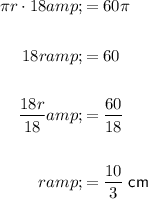Answer:



Explanation:
Question 14
The formula for the lateral area of a cone is:

where:
- r is the radius of the circular base.
- l is the slant height.
If a cone has a slant height of 18 cm and a lateral area of 60π cm², then we can find its radius (r) by substituting the given values into the formula and solving for r:

Therefore, the radius of the circular base of the cone is 10/3 cm.
The formula for the volume of a sphere is:

where r is the radius.
To calculate the volume of a sphere with a radius equal to that of the cone, substitute the found radius of the cone (r = 10/3) into the volume of the sphere formula:

Therefore, the volume of the sphere is exactly (4000/81)π cm³, or approximately 49.4π cm³.

Question 1
The inverse of a statement is formed by negating both the hypothesis (the "if" part) and the conclusion (the "then" part) of the original statement.
The original statement is:
- If the measure of an angle is 90°, then it is a right angle.
Therefore, the hypothesis is "the measure of an angle is 90°," and the conclusion is "it is a right angle."
Negate both parts of the original statement to find the inverse:
- The negation of the hypothesis is "the measure of an angle is not 90°."
- The negation of the conclusion is "it is not a right angle."
Therefore, the inverse of the statement is:
- c) If the measure of an angle is not 90°, then it is not a right angle.

Question 3
The converse of a statement is formed by interchanging the hypothesis (the "if" part) and the conclusion (the "then" part) of the original statement.
The original statement is:

To find the converse of this statement, simply interchange the hypothesis and the conclusion. Therefore, the converse of the statement is:
